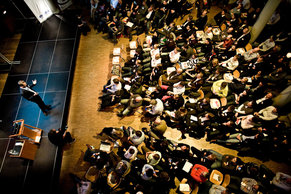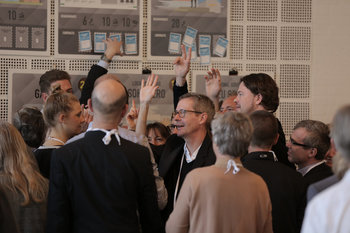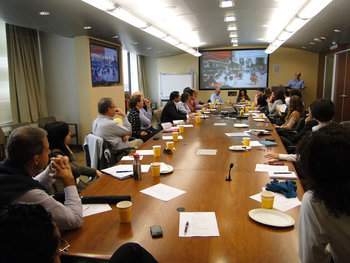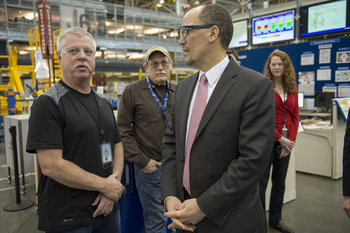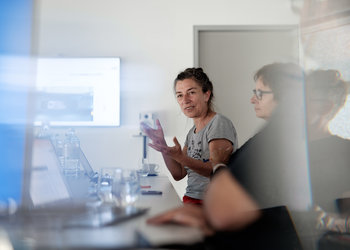
Accountability
A bureaucracy lacks direct accountability to stakeholders such as the public, taxpayers, customers, employees and donors. For example, a government department that is run by administrators as opposed to elected officials. Such a department may ultimately answer to elected officials providing some level of indirect accountability to the society or community they serve.Oversight
A bureaucracy may be monitored and governed by an oversight body that accepts complaints from stakeholders. This may provide some level of accountability if the oversight body has fully authority to remove leadership and takes an active and adversarial stance.Professional Competence
The primary characteristic of a bureaucracy is that it is a system of formal authority based on competency. In a bureaucracy, you are promoted when a system deems you competent. This can be contrasted with formal authority granted by an election, meritocracy, family membership, social connections or revolution.Stability
A bureaucracy provides stability as compared with an elected office. This may be efficient as compared to a system where strategy can completely reverse with every election.Division of Labor
A bureaucracy is run by experts with detailed specifications for every job role that includes a checklist of mandatory requirements for each position. Promotions are assigned based on seniority and an ability to check off mandatory requirements. As such, a very different type of talent rises in a bureaucracy as opposed to a meritocracy that is based on results and potential. For example, a brilliant young engineer with exceptional creative talents, high personal resilience and well developed influencing abilities would tend to rise much faster in a meritocratic organization.Not My Job
Due to the highly specialized division of labor in a bureaucracy, they may develop a culture of "not my job" whereby employees are primarily concerned with clearing issues from their specific area with little concern for the success or failure of programs, projects and operations.Formality
Bureaucracies value formality including policy, procedure, rules and processes.Automation
Due to their embrace of formal processes, bureaucracies embrace automation and attempt to systemize everything.Technocracy
A technocracy is a bureaucracy that is dominated by technologists and focused on automation. This has become so common that it is essentially a more modern term for bureaucracy.Excluded Middle
Due to their strict adherence to formality, bureaucracies are prone to black and white thinking whereby they don't make exceptions even when it makes sense. This is a form of logic known as excluded middle that deals with true or false as opposed to degrees of truth.Hierarchy
Bureaucracies are organized into hierarchies based on formal authority. Informal authority plays little or no role in decision making and strategy.Change
Bureaucracies tend to be slow to change and are prone to defense of the status quo. They might implement change on long road maps of 5 years or more where a small commercial entity would execute the same change in a month.Big Thinking
Due to a preference for long term planning, bureaucracies are prone to developing huge projects as opposed to quick incremental changes.Overthinking
Bureaucracies tend to overthink, overplan and overanalyze every problem and opportunity.Organizational Maturity
Bureaucracies are often organizationally mature such that they pour significant resources into managing compliance, risk and quality. They attempt to follow every standard and best practice they can find.Employee Entrenchment
Most bureaucracies have relatively high job security whereby it is uncommon for employees to be terminated. It may also be uncommon for employees to leave. This leads to a static culture whereby employees may remain entrenched in a position for many years.Red Tape
Red tape is a high level of administrative burden. Bureaucracies are known for their red tape. This extends from other characteristics of a bureaucracy such as overthinking, formality and a lack of accountability to stakeholders.Petty Authority
Petty authority is the use of formal authority to enjoy a sense of personal power. For example, the use of authority to punish others to enjoy a feeling of social dominance. This may be common in bureaucracies due to their reliance on formal authority over informal authority.Malicious Compliance
Malicious compliance is the irrational application of formal rules and processes that has negative motivations. This may be common in bureaucracies due to the powerlessness of employees who lack formal authority such that discover ways to use the system against itself.Efficiency
Bureaucracies are commonly perceived as being inefficient but this isn't always the case. Bureaucracies promote only experts, automate things and adhere to formal processes. This can theoretically be efficient. However, without oversight and accountability a bureaucracy may simply become efficient at making life miserable.| Overview: Bureaucracy | ||
Type | ||
Definition (1) | An administrative system run by unelected officials. | |
Definition (2) | A system of strict formal authority where authority is assigned based on professional competence. | |
Positive Characteristics | StableProfessional competenceHigh organizational maturityEfficient where there is sufficient oversight | |
Negative Characteristics | SlowResists changeHigh overheadOverthinkingBlack & White thinkingRed tapePetty authorityMalicious complianceLacks direct accountabilityMay be inefficient or destructive without sufficient oversight. | |
Related Concepts | ||











